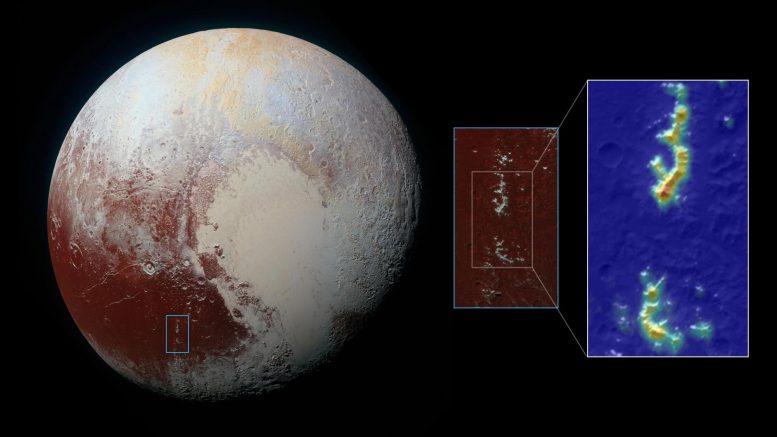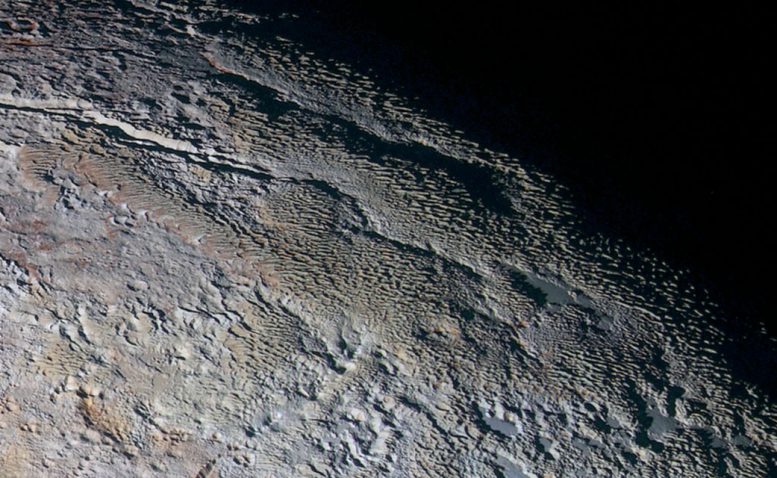
Posted on 10/16/2020 11:33:41 AM PDT by Red Badger

Pluto as seen from data taken by New Horizon’s flyby in 2015 of the dwarf planet, with a close-up view of the Pigafetta Montes mountain range. The colorization on the right indicates the concentrations of methane ice, with the highest concentrations at higher elevations in red, decreasing downslope to the lowest concentrations in blue. Credit: NASA/JHUAPL/SwRI and Ames Research Center/Daniel Rutter
=============================================================================
The mountains discovered on Pluto during the New Horizons spacecraft’s flyby of the dwarf planet in 2015 are covered by a blanket of methane ice, creating bright deposits strikingly like the snow-capped mountain chains found on Earth.
New research conducted by an international team of scientists, including researchers at NASA’s Ames Research Center in California’s Silicon Valley, analyzed New Horizons data from Pluto’s atmosphere and surface, using numerical simulations of Pluto’s climate to reveal that these ice caps are created through an entirely different process than they are on Earth.
“It is particularly remarkable to see that two very similar landscapes on Earth and Pluto can be created by two very dissimilar processes,” said Tanguy Bertrand, a postdoctoral researcher at Ames and lead author on the paper detailing these results, which was published in Nature Communications. “Though theoretically objects like Neptune’s moon Triton could have a similar process, nowhere else in our solar system has ice-capped mountains like this besides Earth.”
On our planet, atmospheric temperatures decrease with altitude, mostly because of the cooling induced by the expansion of the air in upward motions. The cool atmosphere in turn cools temperatures at the surface. When a moist wind approaches a mountain on Earth, its water vapor cools and condenses, forming clouds and then the snow seen on mountain tops. But on Pluto, the opposite occurs. The dwarf planet’s atmosphere actually gets warmer as altitude increases because the methane gas that’s more concentrated higher up absorbs solar radiation. However, the atmosphere is too thin to impact the surface temperatures, which remain constant. And unlike Earth’s upward winds, on Pluto, winds that travel down mountain slopes dominate.

To understand how the same landscape could be produced with different materials and under different conditions, the researchers developed a 3D model of Pluto’s climate at the Laboratoire de Météorologie in Paris, France, simulating the atmosphere and surface over time. They found that Pluto’s atmosphere has more gaseous methane at its warmer, higher altitudes, allowing for that gas to saturate, condense, and then freeze directly on the mountain peaks without any clouds forming. At lower altitudes, there’s no methane frost because there’s less of this gaseous methane, making it impossible for condensation to occur.
This process not only creates the methane ice caps on Pluto’s mountains, but also similar features on its crater rims as well. The mysterious bladed terrain that can be found in the Tartarus Dorsa region around Pluto’s equator is also explained by this cycle.
“Pluto really is one of the best natural laboratories we have to explore the physical and dynamic processes involved when compounds that regularly transition between solid and gas states interact with a planetary surface,” said Bertrand. “The New Horizons flyby revealed astonishing glacial landscapes we continue to learn from.”
Reference: “Equatorial mountains on Pluto are covered by methane frosts resulting from a unique atmospheric process” by Tanguy Bertrand, François Forget, Bernard Schmitt, Oliver L. White and William M. Grundy, 13 October 2020, Nature Communications. DOI: 10.1038/s41467-020-18845-3
Oh, show me round your snow peaked
Mountain way down south
Take me to your daddy’s farm
Let me hear your balalaika’s ringing out
Come and keep your comrade warm.................
It is interesting how different each planets is.
Must be all the farts.
We have methane ice here on Earth, at the bottom of the oceans and under the frozen tundra of the Arctic..............
You’d think Antonio Pigafetta would have had something more prominent named after him than a mountain range on Pluto. Maybe a big crater on Mars.
It’s his name...........
Methane.
Methane one earth is produced by the decay of formerly live objects. Yes, the Hydrocarbon methane is associated with decayed life forms. Natural Gas, coal mine gas are associated with decayed and oxygenated peat bogs, etc.
So lots and lots of methane ice pack probably means that once upon a time there was a lot of life on that planet.
Then there must have been tons of life on Jupiter,Saturn, Uranus and Neptune..................
There’s interstellar methane. I do think the vast majority of origin for methane on the earth is of biotic origin like you said.
Interstellar methane (go down the list to “5 atoms”)
Hydrocarbon production is abiotic, geochemical in nature. Yes, decaying animals release it, but terrestrial oil is not fossil based.
That far out, how did it become warm enough for life (as we know it) to exist?
Thanks Red Badger.
 |
||
| · join · view topics · view or post blog · bookmark · post new topic · subscribe · | ||
| Google news searches: exoplanet · exosolar · extrasolar · | ||
Disclaimer: Opinions posted on Free Republic are those of the individual posters and do not necessarily represent the opinion of Free Republic or its management. All materials posted herein are protected by copyright law and the exemption for fair use of copyrighted works.